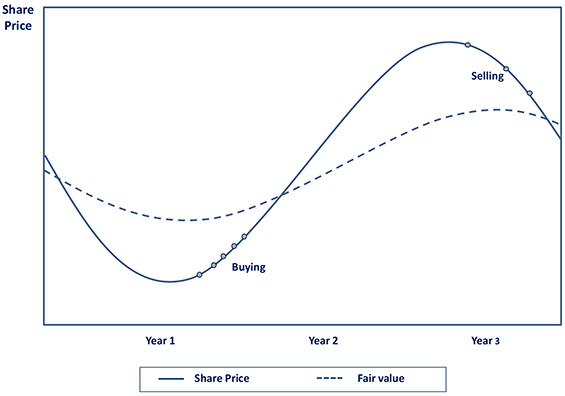Following on from our first two articles on Hope, Fear and Greed investor and Market Psychology, we will briefly outline an oversimplified way of dealing with market and human behaviour.
For the purposes of this illustration, we are going to make the fictitious assumption that we know ahead of time, or well into the future, what any particular stock is worth. I am going to call this assumption "fair value".
As can be seen from the diagram below, "fair value" is illustrated as a dotted line and the actual share price for a stock is the solid line. Stock prices should actually mimic the underlying fair value for stock earnings.
However, due to the emotions of hope, fear and greed, share price movement actually travels a more exaggerated path than underlying earnings and, as many investors will tell you, the share price movement for a stock actually moves ahead of new fundamental information.
If we can accept that share prices "overshoot" on the way up and on the way down then we cannot simply buy shares when they are below "fair value" and sell them when they are above "fair value".

This logic could lead to the very dangerous mistake of buying stocks when they are falling (while they overshoot on the downside) and selling stocks when they are going up (while they overshoot on the upside).
A basic rule of investment is to buy assets that are going up and sell assets that are going down - not buy assets on the way down and sell them on the way up. Hopefully, most investors have different methods for complying with this basic rule.
The way we buy and sell stocks is what we call "scaling into" and "scaling out of" positions. Each incremental buy adds to our overall position in a single stock, and each incremental sale reduces our position in a particular stock.
We believe this has the added benefit of not having to make drastic decisions on an entire position and drastically reduces unnecessary worry over any one particular buy or sell decision.
This method, properly implemented, allows us to make greater returns by letting profits run longer and cutting losses earlier, as well as avoiding additions to losing positions.
We feel so strongly about not adding to losing positions that I would argue the single biggest mistake that most investors make is actually adding to losing positions - followed closely by not letting winning positions run.
The temptation to hang onto losing positions and sell winning positions is the very emotional hurdle that stops many investors from producing better returns. We have hopefully implemented a more evolved version of the diagram outlined above to prevent the roller-coaster ride of emotion from entering into our investment decisions.
This piece is an extract from an article authored by Karl Siegling that appeared on the Morningstar Australia website. Siegling is a portfolio manager with Cadence Capital.